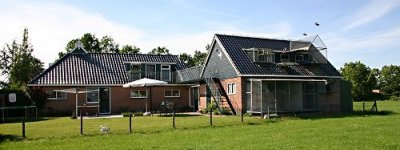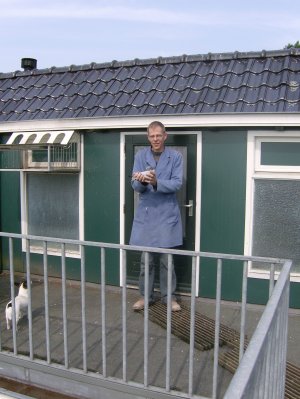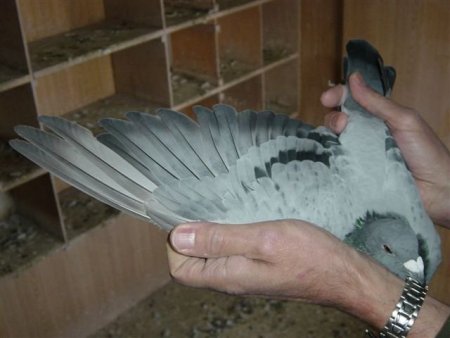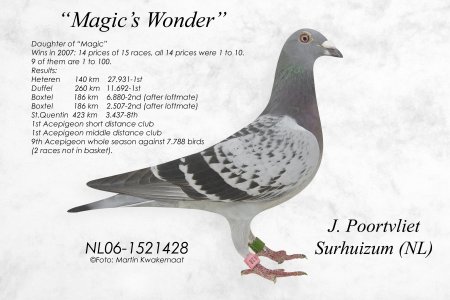He is one of the biggest sensations in Dutch pigeon racing. Had the world at his feet in 2007 winning 1st Nat. championship youngsters and 1st Nat. champion Eendaagse Fondspiegel category 8. With a formidable strain of pigeons he performs sensationally, with exceptional highlight almost every week. Jacob Poortvliet based his lofts on the fine
pigeons from Minderhout/Vandenabeele, Koopman (direct and through others), the lines of Kannibaal’ through Van Dyck, the wonder birds of Marijke Vink and a slice of Janssen Reason to ask him about his methods and matters .
Since 2002 Jacob Poortvliet lives at his present address in Surhuizum. From here he drives 28 pairs of racers to unlimited highs and turns many eggs of his 60 breeding pairs into cracks. About 100 youngsters are bred for racing. The 56 acers are entered on double widowhood rotation system. First the hens are trained, the cocks walk to the hens loft (with perches), the hens walk in the cock loft (with breeding boxes), get some food, the cocks are trained, the hens walk back to their own section and the circle is round. Twice a day training, with the hens training just a bit longer and harder. Sometimes 1,5 up to 2 hours per training. The lofts are closed, but Jacob refuses to train with the flag
and that’s the picture. Youngsters can train practically whole day, sometimes even night and day. At night Jacob lets them out, they can come in themselves and the loft remains opened so they can train early in the morning again! When the darkening is stopped that is.
The youngsters are darkened from medium April up to end May, 6 to 7 weeks in total. In the morning they must go outside and an obligatory training of 1,5 up to 2 hours is at program, also for the youngsters on nests. The rest of the day they are free to train. Old pigeons are not darkened.
Pairing
Breeders as well as racers are paired half December. The eggs of the racers are placed under nurse-pairs (at his father) and the eggs of the breeders are placed under the racers and so the breeders can produce quickly again
This brings him a quick two rounds of the breeders. The racers bring up the youngsters until they are about two and a half weeks olds. The hen and one youngster are than placed on the youngsters loft and the other youngster remains at the cock. The hens can not lay a second time. Medium March the racers are paired again, they get to breed a maximum of 10 days on the eggs and are than put on the widowhood system. Like this the racers keep their feathers longer, it takes a long time before the first pinion is thrown. Beginning of July most of them only threw one or two pinions.
Training
Before the start of the old bird races, they are tossed at least 5 times. Not far, the most important thing is gaining rhythm. Training and coming home
that’s the point. Jacob believes in the importance of just tossing the cock once and the hens once, so they find the partner when returning home. With good weather in the early season, the pigeons are tossed on Thursday or Wednesday in between the races, to get the extra rhythm and to learn the widowhood system for the yearlings. Youngster are tossed minimally 10 times. Only sometimes the weather is bad, or there is no time or they are in bad health
it is very important not to bring them too far than. On about 10 km, just as long until they come home quickly. First than the distance can be enlarged up to 40 km. In between the first four races they are trained on 40-50 km to become more and more experienced. Starting July they are lighted extra from 5.00 until 22.30. The late tour season means training young and old birds together whole day. Jacob believes in between training / tossing is not necessary. He did it the last races because his concurrence did it too and Jacob must be honest
he performed superb on these races!
Feeding
Jacob Poortvliet developed a good feeding system, that did not only succeed for himself, but also for many other fanciers
Jacob about it: I do not like to feed very poor. The mixtures I use for my racers – old and young – are: Gerry Plus (G) of Versele Laga, Soyagold Sport (S) of Mariman, Champion Mix Soyagold (C), All in one = Koopman (K). Furthermore candy seeds, peanuts, grind and hemp.
These mixtures I feed in the racing season; beginning Sunday morning and my starting point is basketing on Friday. When this is Tuesday; all comes one day earlier. Sunday, Monday and Thursday a mixture of G and C, with some additional candy seeds, peanuts and a bit hemp. Wednesday morning all 4 mixtures in equal quantities, that is G, S, C and K added with some candy seeds, peanuts and bit hemp. Wednesday night, Tuesday and Friday morning mix S and K added with some candy seeds, peanuts and a bit hemp, but some more than the beginning of the week. A bit food can remain, especially on Friday, and don’t take the tray away (for the youngsters get it away around noon).
The beginning of the week all must be eaten, but not too poor. Friday morning the youngsters get electrolytes over the food. Beginning of the week the food is poor of protein. It makes them round, but not too heavy so they want to train hard. Wednesday morning is the switching point. Last 4 meals before basketing they must become heavier and form some reserves. When they have no reserves, the results get worse every week. When they arrive home they also get something of all. When there no races, I put all mixtures together. Every 3 to 4 weeks they get a canker product 1 or 2 days. It is also possible to supply a disinfector every 3 to 4 weeks. When they return home, always clear water in the drinking pot. When they are home a few hours, electrolytes are good in the water. Once a week I give vitamins over the food, normally Thursday morning (on Friday basketing). Garlic powder I give also once a week, mostly Wednesday morning.
After a heavy race it is good to give some extra vitamins in the beginning of the week. On Tuesday (the day before basketing) they get Orni Spec in the drinking water (for the upper airways). For the youngsters this is Orni 3 (especially for youngsters). Every time I gave the youngsters electrolytes over the food the day of basketing (in the morning).

Prove of quality
Jacob shows us the latest references coming in and indeed they are a great indication of the top class he houses in his lofts.: The 1st young acebird from Berlin (Germany) winner of 7 from 7, is bred from a Poortvliet hen. This one was bred from a brother to Yildirim’ x nest sister Yilma’, inbred Yildirim’. The 1st provincial acebird from Friesland (Netherlands) in 2007 is a 50% Poortvliet pigeon. From the lines of Magic’s Wonder’, therefore a sister to Blue Magic’ and Ringloze’, from Magic’ and Fritsje’. This pigeon was also 6th prov. Acebird one day long distance and in combine 6th acebird middle distance, 2nd acebird log distance, 4th acebird late tour and 1st old acebird
Unbelievable. The quickest European pigeon on the 200 km one loft race in China is a 50% Poortvliet pigeon. Father is Bonte Menno’ ( Vandenabeele-Janssen) and mother direct Vandenabeele.
Who mentions the name of Jacob Poortvliet in Holland always gets a description with great quality’ and top fancier’ as key words. A man that is not afraid to reveal his system, because he knows it is just that small extra to profit optimally from the most important thing; top pigeons!
Jacob Poortvliet Sensational results in 2007
Heteren (140 km) 239 b.: 1-3-4-6-7-8-9-10-11-12-13-14 etc.
Boxtel (186 km) 234 b.: 1-2-3-4-5-6-7-8-9-10-12-13-15-16-17-18-19 etc. 2.507 b.: 1-2-4-6-7-8-9-10-11-16-20-21-23-26-27-28-29 etc.
Duffel (260 km) 236 b.: 1-2-3-6-7-8-10-11-13-14-16-17-18-19 etc. 7.546 b.: 1
Menen (338 km) 232 b.: 1-2-3-4-5-6-7-8-9 etc.
Pommeroeul (349 km) 6.453 b.: 13-14-15-16-18-23-42-50-56 etc.
Duffel (260 km) 11.692 b.: 1-2 etc.
Pommeroeul (349 km) 179 b.: 2-3-4-5-6-7-9-10-11-13-14-16-17-18-19-20 etc.
St. Quentin (423 km) 140 b.: 1-2-3-4-5-7 etc 3.437 b.: 8-10-11-18-20-33
Heteren (140 km) 375 b.: 1-3-4-5-8-9-10-12 etc.
Heteren (140 km) 334 b.: 2-4-5-6-8-9-10-11 etc. Boxtel (186 km) 319 b.: 1-3-4-6-7-8-9-10 etc. 2.853 b.: 1-6-9-15-16-17-21-22 etc.
Duffel (260 km) 317 b.: 1-2-3-4-5-6 etc. 28.819 b.: 27-36-40-41-51-55
Pommeroeul (349 km) 277 b.: 2-3-4-7-8-9-10-11-13-16-17-18-19-20-21 etc.
Arras (398 km) 222 b.: 1-3-4-8-9 etc. 1.943 b.: 1-10-11-24-26-37-44-46
Heteren (140 km) 27.931 b.: 1.
Morlincourt (459 km) 115 b.: 1-2-3-4-7-8-9-11-12-13-14-15 etc.528 b.: 3-7-10-17-25-28-33 etc.
Boxtel (186 km) 355 b.: 1-2-3-4-5-6-7-8-9-10-11-12-13-14-15-16-17-18-19 etc. 6.880 b.: 1-2-11-16-17-19-22-24-25-26-28-31-32-35-38 etc.
Meer (213 km) 397 b.: 1-2-3-6-7-8-12-13-14-16-17-18-20-21-22-23-24-25-26-27-28 5.786 b.: 2-3-11 etc.
Duffel (260 km) 348 b.: 1-2-3-4-5-6-7-8-9-12-13-14-15-16 etc. 15.489 b.: 21-23-28-30-34-35-51-59-62 etc.
1. National champion young birds
1. National champion one day long distance Eendaagse Fondspiegel cat. 8
1. overall champion combine (not-nominated)
1. overall champion combine (nominated)
1. champion old birds combine (not-nominated)
1. champion one day long distance combine (nominated)
1. champion middle distance combine (nominated)
1. champion youngsters combine (not nominated)
1. acebird one day long distance combine
1. young acebird Long Distance Specialists Club
2. overall prov. Champion (not-nominated)
2. prov. overall middle champion (nominated)
2. champion middle distance combine (not-nominated)
2. champion late tour combine (not nominated)
2. acebird youngsters combine
3. overall prov. Champion (nominated)
3. prov. Champion old birds (not nominated)
3. prov. Champion middle distance (not-nominated)
3. prov. Champion youngsters (not-nominated)
3. champion old birds combine (not-nominated)
3. champion one day long distance combine (not-nominated)
3. champion short distance combine (not nominated)
3. champion late tour combine (nominated)
Combine = 160 fanciers
Provincial = 1.900 fanciers




